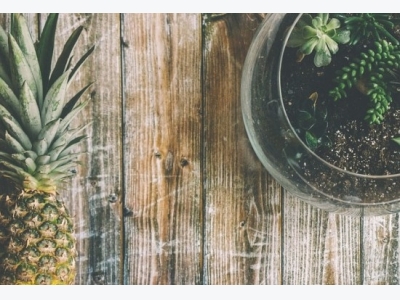How to Grow a Pineapple Indoors

What’s not to love about pineapple?
One sweet, juicy bite reels your senses right into a more tropical version of life. Aside from its sunny flavor and the beachy mental imagery, pineapple is packed with nutrients that can dramatically improve your physical health. From vitamins and minerals to fiber and enzymes, pineapple fruit gives the body a natural boost.
, though. We’ve drummed up the best practices for growing your very own pineapple successfully, and we’re passing it along to you to try. The results won’t disappoint. In fact, the result will be your very own home grown pineapple.
HOW TO GROW AND CARE FOR PINEAPPLE
To grow pineapple, head to the grocery store. Pick out a pineapple that has that golden, ripe, ready to eat look. Take it home, slice it up, and enjoy the fruit. Just don’t throw away the top.
After you’ve enjoyed your treat, take the top with the leaves attached and turn it upside down. You’ll see a core right in the middle of where the leaves spiral together. Start peeling the small, short leaves away one by one from the core until the core is at least an inch long.
Meanwhile, have a 5 gallon container ready and loaded with moist, fertile soil. A good soil mix to start pineapple in includes a good potting soil, some compost, and sand or perlite for drainage. Set the prepared top into the soil with the spiky leaves pointing up. Press the core into the soil to stabilize it. Water your pineapple well.
Allow the soil around your pineapple top to dry. Then, water generously. On top, your pineapple might appear to be dying. The spiky leaves could begin to turn brown and shrivel. Don’t be alarmed though. Underneath, roots will be uncoiling from the core.
The roots in the core will wake up in the moist soil, and they’ll reach into the soil to chase water as the soil dries. When you water it again, the roots will encourage the top to send off new growth. When the soil dries again, the roots will stretch, and the plant will become more and more stable in its container. Until your plant has grown roots to anchor it in, keep it from getting toppled over.
Continue to water your pineapple regularly, and provide your plant with plenty of sunshine. With the exception of the warmest southerly climates where the temperatures remain between 68 and 86 degrees Fahrenheit, keep your pineapple sheltered and warm indoors.
Every other month, feed your plant with a balanced fertilizer. Sprinkle an ounce or two of fertilizer over the soil before watering. Increase the amount as your plant grows.
New, green, sword-like leaves will develop. After about 12 to 18 months, a flower will develop that will become the fruit in another 4 or 5 months. The larger your plant has grown, the larger your fruit will be. You’ll harvest your pineapple at its peak of ripeness. You’ll know it’s ready when half of your pineapple has turned from green to its beautiful ripe, golden color.

PINEAPPLE PESTS, DISEASES, AND PROBLEMS
In spite of that prickly pineapple skin, pineapples are still susceptible to a few diseases and pests. The good news is that most of the problems for pineapples can be avoided with preventative measures. Plant your top in clean soil to begin with. And don’t overwater your pineapple. Provide your plant with plenty of sunshine. These steps will keep your pineapple healthy.
The only other problem you might have to worry about is the other animals and even friends who might want to snatch your irresistible fruit before you get the chance to enjoy it. Keep it under the cover of a paper bag if you have to!
PINEAPPLE VARIETIES
‘Smooth Cayenne’ is the most commonly grown pineapple. It’s a larger plant that produces large fruit around 5 pounds. Its sweet flavor is hard to beat.
‘Queen’ is a smaller variety that produces fruit in the 2 to 3 pound range. This fruit stores well after harvested.
‘Sugarloaf’ has a unique white flesh. It’s another larger variety with fruit weighing around 5 pounds. The core of this pineapple is soft and edible.
Có thể bạn quan tâm
 Make Your Own Seed Capillary Mat: Self Watering Trays
Make Your Own Seed Capillary Mat: Self Watering Trays Once you’ve planted your seeds indoors, they need just the right amount of water to germinate and mature. Capillary mats, also called self watering trays
 How to Control Ants in Your Garden Naturally and Safely
How to Control Ants in Your Garden Naturally and Safely The ants in your garden aerate the soil, eat the eggs and larvae of insect pests, and pollinate certain flowers.
 How to Plant and Harvest Lavender
How to Plant and Harvest Lavender For centuries, lavender (Lavendula) has been prized for its beauty, medicinal value and aromatic scent. The ancient Romans used lavender in their baths.